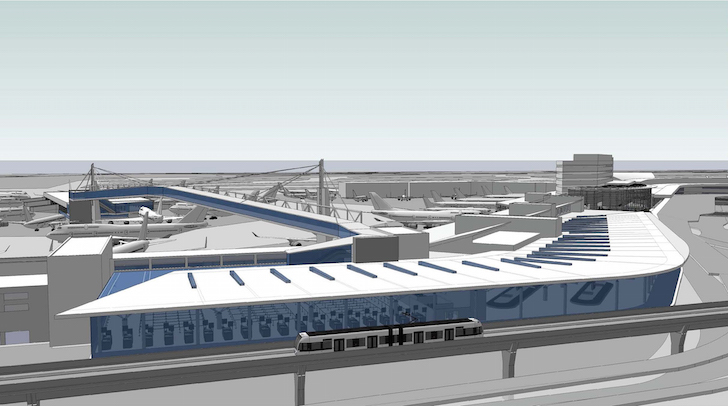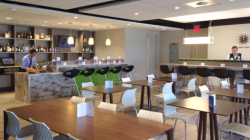I’m not an airport manager, architect, or anyone qualified to determine the best way to build an airport. But some of the plans for expanding Seattle’s airport strike me as especially odd.
The problem is the port authority believes passenger traffic will roughly double in the next two decades, overwhelming the existing 81 gates. That isn’t difficult to imagine given all the cranes downtown. Some parts of the city are completely changed from what I remember when I moved here 8 years ago.
And of course there’s Delta. They’ve long had a mini-hub here for international departures and are trying to expand their domestic presence, too. The entire international arrivals hall is a mess. Plans are already in place to expand the South Satellite (international flights) and connect it to a new arrivals hall at the end of the A Concourse. The North Satellite, where Alaska Airlines recently kicked out United, is also planning a significant renovation.


But that won’t be enough. Some plans call for adding an additional 35 gates and even a second passenger terminal. A report by the Seattle Times yesterday outlined three proposals for additional expansion that are not mutually exclusive (free access and illustrations; additional details can also be found on the Port of Seattle website).
Three New Plans for Expanding SeaTac
One would see the A Concourse (where United is currently situated) extended to wrap around the southern perimeter of the airport. I think this is ludicrous without significant improvements to the terminal transportation system. I don’t actually mind the underground trains that are required to reach the satellite concourses, but it takes 10 to 15 minutes to walk to the end of the Concourse A, which has only a handful of relatively slow moving walkways. Why make that situation even worse?
A second plan would be to enlarge the passenger check-in and ticketing area. This would require reconfiguring the roadways leading to the airport for passenger drop-off. That road is the only empty space between the terminal and the short-term parking garage. I’m not necessarily opposed to this, but I don’t see the need. Passenger check-in at SeaTac has typically been less of a mess than at other major airports. If they need more space for security checkpoints, consider that the airport already has four and rarely operates all of them outside of peak demand. Some ground-side restaurants could be closed to expand them if necessary.
The third plan is the worst idea in my mind: build a second passenger terminal north of the current terminal, where the Doug Fox parking lot is located. It would add lots of new gates, but it also looks crowded and may add lots of road congestion as well, forcing road traffic through that terminal before you reach the current one. Will the train system be extended, or will passengers have to take buses to connect and re-clear security? Why not extend the existing building and create a “W” shape instead of the current “U”?
What I’d Like to See
How about an extension of the existing terminal that connects it to the North and South Satellites? Even over long distances, physical connections between buildings make it easier to transfer between flights or rush when you’re running late. The South Satellite would be an especially good candidate for connecting to Concourse A, much as Concourses B and C currently branch off the main building. Instead, the plan for the new international arrivals hall is to connect it with an above ground skybridge. If you look at the renderings, they suggest a Boeing 747 passing beneath the skybridge. How high will this thing be? It’s crazy.
No One Wants to Pay
Then we get to the money. Alaska and Delta are feuding over who will pay for the South Satellite renovations and international arrivals hall. Obviously Delta wants to spread the cost around because they’re the ones who will use it the most — the South Concourse sometimes looks like a Delta terminal even though it also serves most other international departures. Alaska doesn’t want to pay a dime, arguing that the majority of domestic passengers — its own customers — will rarely use it.
Like all public infrastructure projects, funds are often raised for the public good and not on the basis of fairness. But I see Alaska’s point. When airports build fancy new off-site rental car facilities, they may impose fees as high as $20 per customer — but only if you rent a car, even though everyone benefits from reduced congestion at the terminal. It isn’t an automatic requirement that everyone share the pain. I don’t buy Delta’s argument that higher fees targeting only international customers will make the airport unprofitable as a West Coast gateway. Air travel in Canada is already so expensive that their citizens drive down to places like Bellingham. Why would we drive (or fly) to Vancouver on our way to Hong Kong? Portland, Oakland, San Diego, and San Jose have minimal international traffic. And San Francisco and Los Angeles face significant congestion issues already as well as the higher fuel costs of departing from more southern latitudes.
Create One Comprehensive Plan
I guess what really bothers me is that the entire design process seems haphazard. The current terminal operates as a whole — even with the satellites, there is a system in place that seems to keep everything compact and connected. Spreading stuff out — long terminal extensions, separate buildings, and pedestrian walkways — makes the SeaTac of the future look like a place I won’t want to visit.




